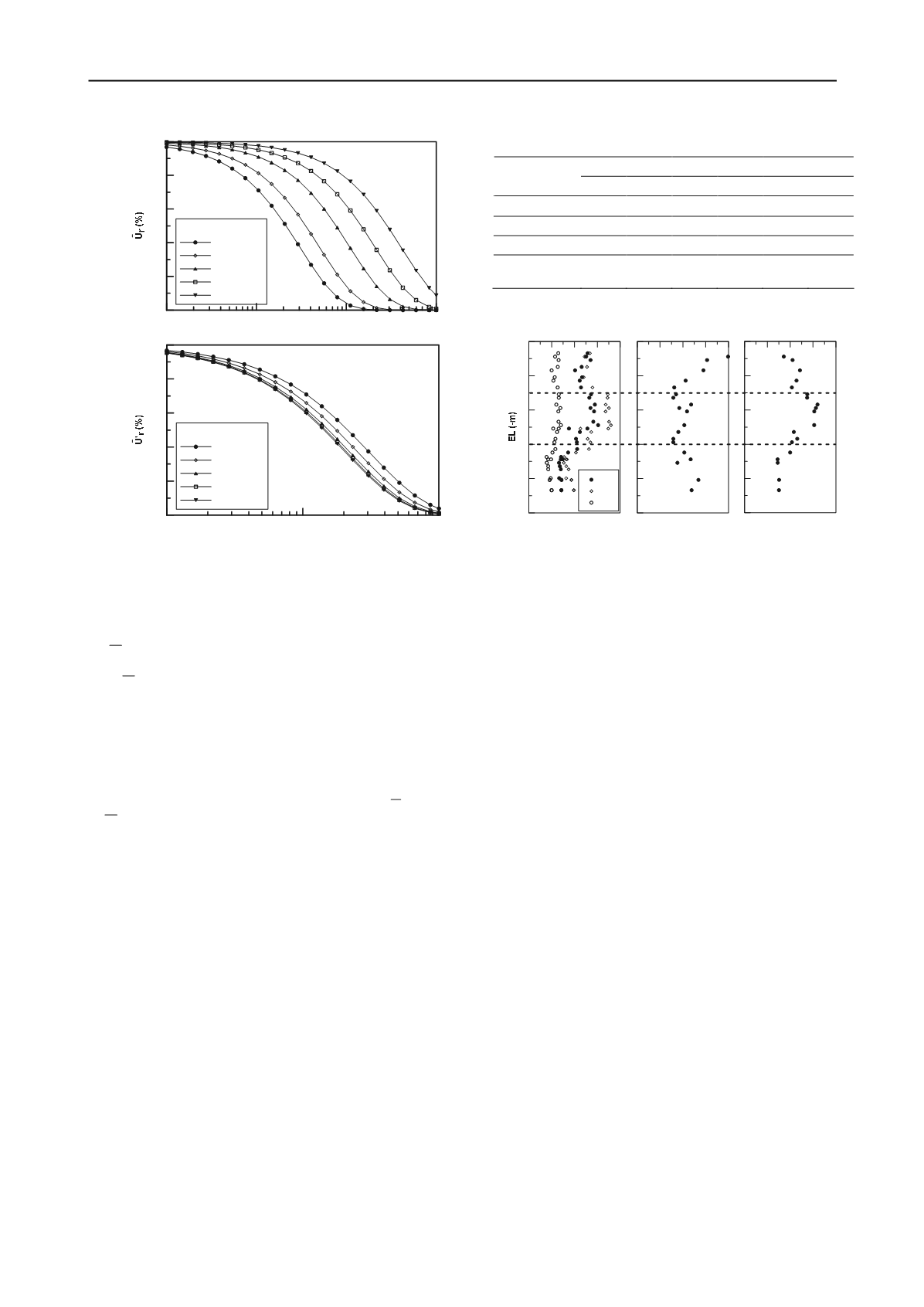
2530
Proceedings of the 18
th
International Conference on Soil Mechanics and Geotechnical Engineering, Paris 2013
k h /k s =1
k h /k s =2
k h /k s =5
k h /k s =10
k h /k s =20
0
60
40
2
k h /k s =1
k h /k s =2
k h /k s =5
k h /k s =10
k h /k s =20
figure 1. effect of k
h
/k
s
on the degree of consolidation: (a) hansbo
’
s
method, (b) proposed method
is the same as the consolidation coefficients ratio between the
undisturbed and disturbed zones (c
h
/c
hs
). By using this
condition, rearranged the average degree of radial consolidation
(
r
U
'
) is
) ' /
8 exp(
1 '
s
hs
r
T
U
(2)
where, µ
’
s
= ln(d
s
/d
w
)+[ln(d
e
/d
s
)+
π
·
z(2l-z)(k
h
/q
w
)-0.75]/(k
h
/k
s
),
t
hs
is a time factor based on c
hs
.
the permeability reduction in the disturbed zone, frequently
represented as k
h
/k
s
, is important factor for the vertical drain-
enhanced consolidation. the effect of k
h
/k
s
on the analysis
results is investigated both hansbo
’
s solution and modified
solution. figure 1 shows the effect of k
h
/k
s
on
h r
T U
and
hs
r
T U
'
curves. other factors are maintained as a constant
value (d
e
/d
w
=25, d
s
/d
w
=5), and well resistance is ignored.
as shown in figure 1(a), the rate of consolidation by
hansbo
’
s method is continuously retarded with increasing in
k
h
/k
s
. however, the consolidation rate by proposed method
(figure 1(b)) is slightly speeded up and finally converged with
increasing in k
h
/k
s
, because the rate of vertical drain-enhanced
consolidation is governed by the permeability of disturbed zone
(Basu and prezzi 2007).
3 application (BUsan neW-port site)
the consolidation behavior in Busan new-port site is analyzed
to verify the proposed analysis. the rate of consolidation
settlement is evaluated by hans
bo’
s solution and modified
solution, and these results are compared with observed
settlements in field.
3.1
Soil properties of clay layers
the profiles of clay layer properties (Busan new-port) are
shown in figure 2. the natural water content (w
n
) and liquid
limit (w
l
) vary 35~75% and 40~80%, respectively. the plastic
limit (w
p
) exists in relatively narrow range from 20 to 30%.
table 1. Void ratio and compression index of each clay layer
layer 1
layer 2
layer 3
property
U r U r U r
e
l
1.81
2.22
1.35
e
0
1.65 1.32 1.95 1.46 0.94 0.78
c
c
0.84 0.46 1.04 0.57 0.57 0.34
c
v
(10
-4
cm
2
/sec)
7.1 3.8 13.0 4.8 22.0 5.0
note. U: undisturbed clay, r: remolded clay
figure 2. profiles of soil properties
although ocr at shallow depth is slightly larger than 1, the
clay layers can be presumed normally consolidated. Busan clay
can be divided into upper and lower clay layers based on el -
30m.
3.2
Consolidation properties of each clay layer
in this study, the clay layers of Busan new-port are divided into
3 layers for the consolidation analysis based on the soil
properties. the consolidation tests were carried out for 50
samples for the natural clay and 3 samples for the remolded clay
to figure out the consolidation characteristics of clay layers.
table 1 shows the void ratio, compression index (c
c
) and
coefficient of consolidation (c
v
) representing the each clay
layer.
3.3
Extent of the disturbed zone
in this study, several assumptions are made to evaluate the
extent of the disturbed zone: 1) the soil adjacent to the drain is
completely remolded. therefore, the void ratio of the clay
adjacent to the drain is the same as that of the remolded clay at
the same effective stress level; 2) the void ratio reduction due to
the disturbance around the drains occurs faster than the
consolidation settlement under a surcharge load. therefore,
ground settlement that occurred without applying the surcharge
load is mainly caused by the void ratio reduction due to the
disturbance; 3) the extent of the disturbed zone and the variation
of the void ratio within the disturbed zone are a invariable
property with depth; 4) the shape of disturbed zone is a circular
cross section. With these assumptions, the extent of the
disturbed zone is evaluated from measured ground settlement,
which occurred in the interval between pVd installation and a
surcharge loading.
Burland (1990) suggested that the e-log
σ'
v
relation for the
remolded clay:
) '
log
(
v
L r
BA e e
(3)
where, e
r
is the void ratio of the remolded clay, e
l
is the void
ratio at the liquid limit, σ'
v
is a vertical effective stress (kpa),
and a and B are constants. for Busan clay, the values of a and
B are 1.224 and 0.256, respectively (hong 2011). therefore, the


